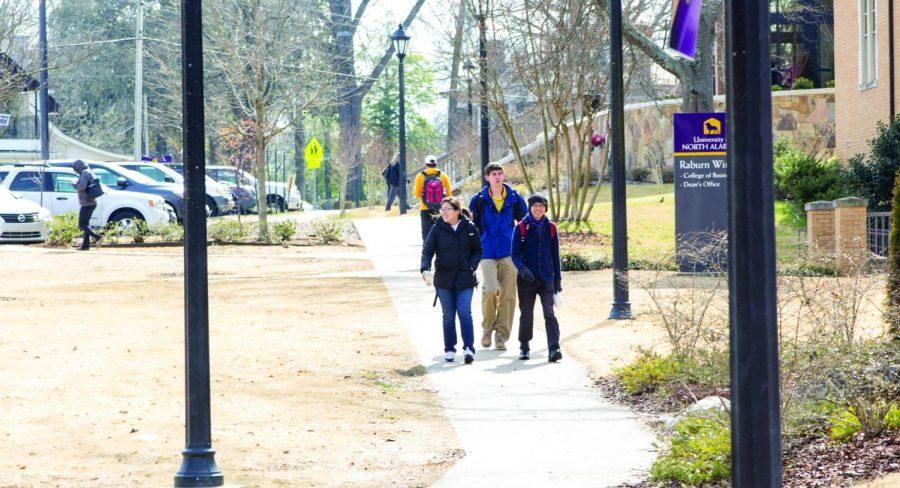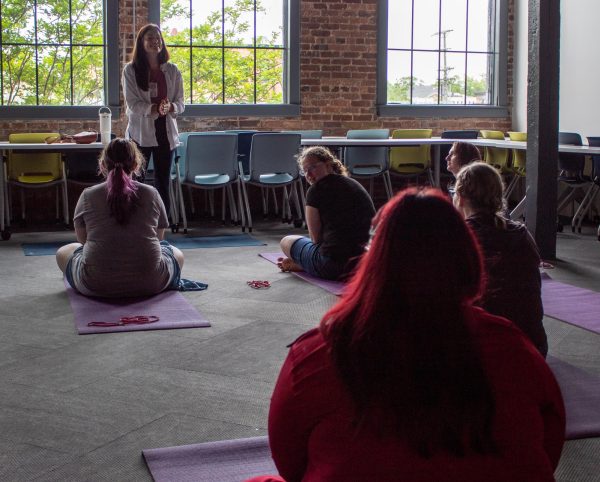Research raises questions about campus diversity
Three students walk across campus Feb. 23 outside Keller Hall. University research shows the student population is more diverse than the faculty and administration.
February 26, 2015
Many administrators and students agree on one aspect at UNA — equal representation is a must.
Because Alabama’s diverse population funds public universities like UNA, the entire campus — faculty, staff and students — should be diverse as well, said Chief Diversity Officer Thomas Calhoun, interim vice president for Academic Affairs.
“Diversity is so inclusive of so many different groups that I believe any of those should be represented at the university and certainly all of those who would like to be part of the university should be at the table,” Calhoun said.
The senior leadership of the university includes the executive council — the president, five vice presidents and the athletic director — which is six white males and one African-American male. The Council of Academic Deans, also part of the UNA administration, includes three white males, two white females, one African-American female and one Asian male.
Of those administrators, 21 percent are female, and 21 percent are minorities.
While the administration has more members that are white, male or both, the student body at UNA is more diverse with about 58 percent females and 29 percent reported as nonwhite, nonresident aliens or unknown, according to research conducted by the Office of Institutional Research during fall 2014.
“The numbers just speak for themselves,” said Lisa Minor, professor of English. “When decisions are being made about curriculum, policies, and all that, those who are making those decisions should reflect the student body.”
A profile provided by the Office of Human Resources shows 15 percent of faculty members reported as minorities.
Freshman Cornia Anderson and sophomore Kyungmin Park from South Korea said there is a need for more minority faculty members, especially for international students.
“There are barriers between nonwhite and white,” Park said. “I think it would be better if we have nonwhite faculty members who can lead us to break those barriers.”
Minor, who has been teaching at UNA for 26 years, said strides have been made toward more diversity but there have always been people who are resistant to it.
“I wish I were starting my career at UNA now, at this point, rather than when I started 26 years ago,” she said. “I think we’re ready for that next step in terms of gender equality and also racial diversity.”
Seeing the number of women now on the dean level makes her hopeful, she said, but she would like to see progress in racial diversity too.
“I have felt over the course of time that there has been a resistance toward more African-American faculty,” she said. “I’d like to believe that’s changing.”
Senior Joey Wright said he does not think gender should be questioned when it comes to hiring, but that traditional ways of thinking have negatively affected the issue.
“Because this is a university and because we’re located in the South, I think it’s more political than anything else,” Wright said. “Who gets all the support around here? Guys do.”
Calhoun said historically males have “dominated” the workforce.
There are many factors that figure into the hiring process, but qualifications always take priority over everything else, Calhoun said.
“We want the best candidates,” he said. “The best candidate needs to be the best candidate irrespective of what racial, ethnic, gender, sexual orientation, etc. group that they come from.”
Efforts are made to keep the hiring committees diverse, he said. There is gender balance, but there may not be a person of color on every committee because there are so few at the university.
First-year graduate student Shelby Heathcoat said things seem to be getting better, but a balance between men and women should still be a priority.
“I still think because the larger part of the population here at UNA is females there definitely is more change that needs to happen to get a better representation of that,” she said.











